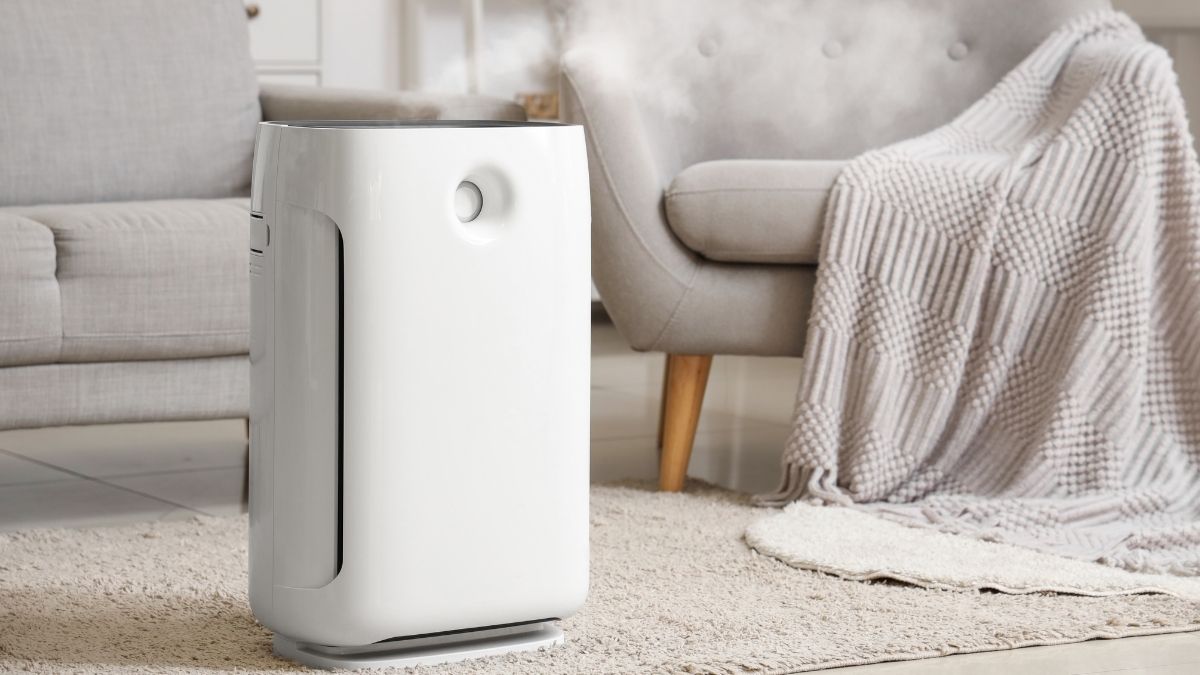
If you’ve ever woken up in the middle of the night with a stuffy nose or irritated sinuses from the air in your bedroom, you likely need an air purifier.
They’re easy to operate, generally budget-friendly, and once you’ve had a night’s sleep with the air free of dust, allergens, and pet dander, you’ll never want to be air purifier-deprived again.
So, what does an air purifier do and how does it work? Let’s find out.
What Is an Air Purifier?
An air purifier is an electrically operated device that improves the air quality in your living space by removing particles such as dust, pollen, and pet dander from the air.
How Does an Air Purifier Work?
While air purifiers might seem complex, their core function is quite straightforward. Here’s a closer look at how they work:
Basic Filtration Mechanism
An air purifier uses a fan to draw in air and then directs it through a series of filters that trap things like dust, pet dander, and pollen.
Common Technologies Used
Modern air purifiers often use high-efficiency particulate air (HEPA) filters to capture tiny airborne particles. Another type is a carbon filter that is used to remove gases and odors from the atmosphere. There are also UV (ultraviolet) air purifiers that can help zap unwanted bacteria and viruses.
The Role of Filters in Capturing Pollutants
The next question you may want to ask is: What does an air purifier help with? In explaining, it is important to understand their role in capturing dirt and pollutants from the atmosphere.
First, they can trap particulate matter because the openings in HEPA filters are smaller than the debris in the air. For example, HEPA filters are designed to capture 99.97% of particles as small as 0.3 microns in size.
Activated carbon filters use an absorption process that works by causing gaseous molecules to stick to the surface of the filter. This type of activated carbon is very effective at trapping volatile organic compounds (VOCs), odors, and other gaseous pollutants.
That said, a study on the Efficacy of the HEPA Air Cleaner found that to get the best results from a HEPA air purifier, you need enough machines for the space, good airflow, and limited open windows.
Types of Pollutants Air Purifiers Remove
Air purifiers tackle a range of common pollutants that can trigger allergies, cause odors, or simply make your air feel less fresh. Here’s a look at the main types of airborne nasties they can get rid of:
Dust and Allergens
Air purifiers using HEPA filters are capable of trapping large particles like dust or lint along with smaller particles having diameters as low as 2.5 micrometers (PM2.5).
Smoke and Odors
They can also help remove smoke particles from the air, as well as odors from cooking and pets.
Pet Dander and Hair
If you’re a pet owner, you might be thinking, Does an air purifier help with dog hair and cat hair? Yes, it does, so if you want to breathe easier when you’re with your baby, consider getting an air purifier.
Mold Spores and Bacteria
If you have any type of mold allergy, an air purifier will trap mold spores and prevent them from causing allergy symptoms or exacerbating an existing condition.
Volatile Organic Compounds (VOCs)
An air purifier with an activated carbon filter can help remove and neutralize gases (VOCs) emitted by things like household products, cleaning supplies, and building materials.
Benefits of Using an Air Purifier
Now you know what an air purifier fan can do. Let’s answer the next burning question: What does an air purifier do for your home?
Improved Indoor Air Quality
Air cleaners remove different types of pollutants from the air, like dust, pollen, pet hair, mold spores, and smoke, leaving you with a healthier and more comfortable environment.
Allergy and Asthma Relief
If you are an asthmatic (or if someone close to you is), an air purifier can help immeasurably with respiratory health. Studies have shown that air purifiers can help reduce asthma symptoms and attacks [1].
Better Sleep and Overall Wellness
By reducing allergens in the air, air purifiers can improve your sleep quality. This allows you to rest more soundly and wake up energized and refreshed, complementing the clean sleep surface provided by a good mattress.
Reduced Airborne Illnesses
Air purifiers with HEPA filters and UV light can help dramatically reduce the risk of airborne viruses and bacteria like SARS-CoV-2 from the air [2].
Where To Use an Air Purifier
Although air purifiers are often thought of for homes, their benefits extend to various settings where people spend time, helping to create healthier, more comfortable air. Here’s where you might find them most useful:
Homes and Apartments
What does an air filter do in a house or apartment? The answer is just about everything. It’s great to have one in the bedroom (consider elevating it) where it can eliminate impurities that can disturb your sleep, like dust mites and pet dander.
It’s also great to have one in the kitchen to eliminate cooking orders. Or, if you live in an urban area, a home air purifier can help with pollutants from outside.
Offices and Workspaces
An air purifier is a great idea for the office to help lower the spread of bacteria and dust and potentially reduce employee sick days.
Schools and Public Buildings
An air purifier in a school can help prevent the spread of contagious diseases by trapping bacteria before they can spread and cause illness, keeping everyone healthy [3].
Cars and Small Spaces
This might sound absurd to some, and they may ask: What does an air filter do in a car? Air purifiers designed for automobiles function much like home units, helping to remove dust, bacteria, gas, and engine smells that accumulate during a drive, and significantly reducing exposure to air pollution from outside.
Limitations and Misconceptions About Air Purifiers
Air purifiers are powerful tools for improving indoor air quality, but they aren’t magic boxes that solve every air problem. It’s essential to understand what they can and cannot do and to clarify some common misconceptions, so you have realistic expectations.
What Air Purifiers Can’t Do
- Remove Pollutants From Surfaces: Air purifiers can only remove airborne pollutants. Bacteria or dust that has settled on a surface need to be cleaned by other means.
- Eliminate Mold: Mold is a surface phenomenon and must be cleaned by hand. It cannot be eliminated by an air filter.
- Improve Poor Ventilation: Air purifiers don’t bring in outside air; they only filter the existing air in a space. Ventilation needs to be addressed separately.
- Kill Bacteria and Viruses: Some purifiers claim to kill bacteria, yet according to the California Air Resources Board, this is unlikely at the low ozone levels these machines provide [4].
Common Myths About Air Purifiers
Some common myths about home air purifiers are that they dry out the air or only benefit allergy sufferers. The truth is, air purifiers don’t impact humidity and, by cleaning the air, they benefit everyone. For optimal air insights, consider using an air quality monitor to track indoor air pollution and ensure your purifier is truly effective.
Choosing the Right Air Purifier
Here’s what to focus on when you’re shopping for an air purifier:
Room Size and CADR Ratings
If you’re thinking “what size air purifier do I need?” the first thing to think about is the room size. Based on that, the next crucial thing is a machine’s CADR (clean air delivery rate). This rating shows how much clean air a machine can produce for a specific particle size per minute in a specific cubic foot area (CFA). The higher the number, the faster the machine purifies.
At this point, you may also find yourself asking: how many air purifiers do I need? You ideally need one air purifier for each enclosed room. Air purifiers work best within a specific square footage, and their effectiveness is greatly reduced by walls and closed doors, so a single unit typically can’t clean your entire home.
Filter Types and Maintenance Needs
- HEPA Filters: These remove 99.97% of airborne particles like dust, pollen, mold spores, and bacteria as small as 0.3 microns. They are not washable and need to be replaced every 6 to 12 months.
- Activated Carbon Filters: These remove odors and some gases and chemicals from the air and need to be replaced every 3 to 6 months.
- Pre-filters: These are there to get bigger particles like dust and pet hair, and are used to extend the life of the main filter. As a result, pre-filters need to be changed every 2-3 months.
Noise Levels and Energy Consumption
Depending on your needs and preferences, the noise levels of air purifiers are measured in decibels (dB) and range from whisper quiet (20 dB) to vacuum cleaner volume (70dB). The power consumption of most air purifiers ranges from 30 to 100 watts, roughly equal to that of a standard laptop computer.
Expert Insights
What does an air purifier do for you if you suffer from allergic rhinitis (AR)? According to one study, HEPA purifiers can help people with AR by significantly reducing the amount of indoor allergens they’re exposed to [5].
Another study found that air purifiers can significantly lessen the common triggers of asthma symptoms and attacks caused by various contaminants like smoke, pollen, and dust [6].
 11 Niche Experts
11 Niche Experts
 100+ Product Reviews
100+ Product Reviews
 50+ Tested Products
50+ Tested Products
At BestDaily, our mission is simple: to help you make confident, informed decisions about the products that impact your daily life. Whether you're searching for wellness essentials or lifestyle upgrades, we combine hands-on testing with expert analysis to highlight what truly works.
FAQs ON Air Purifiers
This article has answered questions like: What does an air purifier do, and how do I know if I need an air purifier? But if you’re still curious about air purifiers, here are answers to common questions people ask.Can an Air Purifier Remove Dust and Pet Dander?
Yes, air purifiers can remove both dust and pet dander effectively by using a HEPA filter designed specifically to capture tiny particles of that exact type and keep them from circulating.
Do Air Purifiers Eliminate Odors?
Yes, air purifiers equipped with activated carbon filters absorb odor-producing molecules and prevent them from circulating in the air.
Can an Air Purifier Help With Asthma?
Yes, by filtering allergens like pet dander, pollen, and dust, an air purifier can lessen the potential contaminants that can trigger an asthmatic episode.
Do Air Purifiers Kill Bacteria and Viruses?
An air purifier can only remove a virus if it is airborne. Viruses and bacteria that exist on surfaces must be cleaned by hand using the proper cleaners and disinfectants.
What Is the Difference Between an Air Purifier and a Humidifier?
An air purifier removes allergens and various pollutants from the air, while a humidifier adds moisture into the atmosphere to combat overly dry air.
What Does an Air Purifier Do? Conclusion
If you suffer from asthma or allergies, you already know how beneficial an air purifier can be.
If you’re a reasonably healthy person who is thinking, “How much does an air purifier cost, and do I really need one?” You might be pleasantly surprised at how much better you’ll sleep in a room with purified air; plus, a pretty decent air purifier is eminently affordable.
Take a deep breath and then think about how you felt when you woke up this morning. If you had needed to get up and walk around to unstuff your nose, the choice should be clear.

